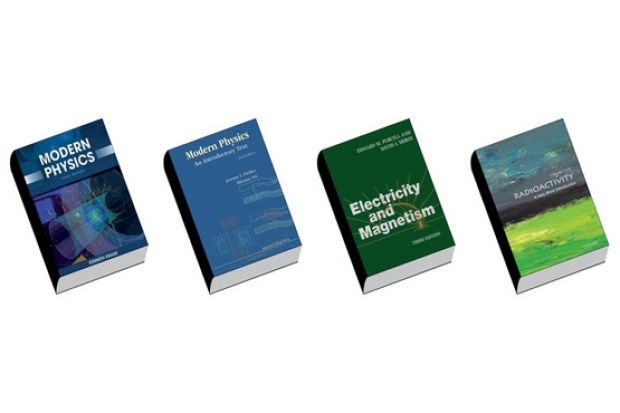I’m always on the lookout for modern physics texts for introductory courses on properties of nuclei and particles. Of this year’s crop, Krane’s Modern Physics covers a lot of territory including Fermi-Dirac statistics, Maxwell-Boltzmann distributions and nucleosynthesis, but its coverage of nuclei lacks some things I look for. The semi-empirical mass formula may not be new or trendy but it does address the basic principles of how one might build a model that describes nuclei. I could not find any nuclear models at all in Krane, whereas Pfeffer and Nir’s Modern Physics: An Introductory Text at least has a page or so of hand-waving model discussion. Krane’s coverage of elementary particles is confined to a quick summary, but I appreciated seeing female physicists fairly well represented in biographies in the margins for a change, and there is an impressive number of worked examples. Pfeffer and Nir’s text, intended for non-physics science majors, grew out of a course offered in the faculty of agriculture, food and environment at an Israeli university: if agriculture students in the UK or my native Canada knew even a third of the material here, I would be pleased.
For a first- or second-year modern physics text, pick Krane for a standard choice of topics and worked examples covering statistical and quantum physics, and for a more novel approach, Pfeffer and Nir as a supplementary text on nuclear physics and radioactivity.
Renewable energy is necessarily a multidisciplinary topic, and Ehrlich’s Renewable Energy: A First Course offers a solid grounding in an evidenced-based approach that uses the physics and maths skills that one would expect of students near the end of their first year or into their second year. In addition to the physics, it also tackles the minefields of politics, public opinion and economics, and comes wrapped in a beautiful cover that illustrates the whole point of the topic: clean skies, wheat fields and birds. I will also recommend it to colleagues teaching courses on energy and on climate change.
Some time ago, I was using the third edition of Serway and Jewett’s Physics for Scientists and Engineers with Modern Physics and always found it clear and helpful. When I spotted the ninth edition, I knew it was time for an update, and this version does not disappoint. It covers the same material as Young and Freedman’s popular University Physics; but, apparently unlike those authors, Serway and Jewett know how many significant figures an answer should have. In a bid to train students to solve physics problems, they use the steps “conceptualize, categorize, analyse”, which I find awkward because it interrupts my train of thought and imposes a rigid separation between these steps, although students seem to find it helpful. It offers conceptual examples – I would call them “quickie questions” – and “what ifs” that address the sort of questions the better students ask after you give a simplified example. Its modern physics section covers only relativity, so although instructors for first-year, and possibly some second-year, physics will find it excellent, it will not aid in teaching nuclear, particle or quantum physics.
In weighing Purcell and Morin’s Electricity and Magnetism for its suitability for first-year courses, I found it to be a beautiful textbook, carefully planned and comprehensive. Magnetism is derived as a relativistic effect, a new force that must be added to the electric force when charges are not stationary. Differential vector operators are used extensively and the subject matter is beyond what our department has been teaching in first year, so it may suit second-year courses better. Chapters conclude with many problems and exercises, and there are fully worked solutions; I will cherry-pick suitable ones for my first-year students.
A few cosmology-cum-particle-physics books caught my eye, including Prakash’s Dark Matter, Neutrinos, and Our Solar System and From the Cosmos to Quarks: Basic Concepts in Physics by Chaichian et al. The former is packed with theoretical and experimental information about astrophysics, cosmology, particle physics, neutrino physics and space science. Its insightful descriptions would appeal to a diverse audience, but the maths is most suitable for senior undergraduates or postgraduates.
Chaichian’s target audience is junior-level undergraduate students, high-school (or A-level) students and non-specialists, but I would not recommend it for high schools, and many topics would be most appropriate, with guidance, for second- or third-years. It covers a mix of topics: classical mechanics in the context of planetary motion, electromagnetism including Fourier series and tachyons, statistical mechanics, fundamental forces, and relativity including wormholes and dark matter. Caution: don’t use this textbook alone! Your students will crash.
Useful non-textbook titles for students (or instructors) seeking contextual information or anecdotes include Tuniz’s Radioactivity: A Very Short Introduction, an enjoyable discussion of the light and dark side of radioactivity, with excursions into topics such as using neutrinos to monitor stores of radioactive material. Ferguson’s chatty, comprehensive Nuclear Energy: What Everyone Needs to Know is aimed at general readers and covers technical, practical, historical, political and economic considerations.
Higgs: The Invention and Discovery of the ‘God Particle’ (Baggott) tells a snappy story about people and ideas. It quite rightly begins with Emmy Noether, who recognised the relationship between natural symmetries and conservation laws in one of the most beautiful leaps of intuition ever. The tale unfolds like a science soap opera, with claims and counterclaims, blunders and regrets, and triumphs of talent and perseverance (perhaps not that much like a soap opera after all), and culminates in the thrilling discovery of something Higgs-ish at Cern.
Tap and scroll down for links to all Physics textbooks
Or view PDF below
